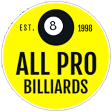Having shown you the correct stance and bridge hand distance, Anthony now explains how you should grip the cue. He shows you how to determine the right grip pressure, what your fingers should be doing when shooting, and how to stay consistent when stroking. Stay tuned for the next episode, when Anthony will explain the various types of bridges you’ll use.
Transcription
Hello, I’m master instructor Anthony Beeler and today I want to talk to you about the correct grip. And today we’re going to look at the correct grip pressure, we’re gonna look at which fingers need to be on the cue, and we’re gonna talk about how your wrist needs to be pointed whenever you get down on the shot. So, lets go to the table and see what that looks like.
The first thing I want to talk to you about is how to form the correct grip pressure. In order to do that, what you’ll want to do is take your cue and hold it upside down like this. You will relax your fingers, to the point where the cue first starts to slide. The point at which the cue first starts to slide down is the correct grip pressure.
The second element of a good grip is the fact that it opens and closes. A good grip will open on the back swing, and close on the forward swing. Open, close, open, close. And this is what it looks like at the table. You’ll notice that the grip opens… and closes. Open, close.
Another important aspect of the grip is that you don’t want it torqued to the right or to the left. You want to come straight down, as an extension of your forearm. So, whenever you’re down on the shot it looks like this. You’ll note this part of your hand is looking straight down the barrel of the cue. You don’t want it torqued out like this, or like that. Coming straight through is the correct way.
I also want to talk about the purpose of the pinky finger and the thumb. The thumb’s purpose is to keep the cue from rolling off onto the floor. There’s no real pressure from the thumb, other than the fact that it just holds the cue in place. Your pinky finger should never touch the cue. If it does, it can distort the shot line. So, as you’re opening and closing, you want to keep that pinky finger off the cue.
The purpose of the grip is to hold the cue. You don’t want to hold your cue too tight. You don’t want to hold it too loose. You want to use the correct grip hand pressure, as we just showed you. You also want to be sure that your grip opens on the back swing, and closes on the forward swing. And you never want to have your pinky finger on the cue, cause it can throw your shot off-line. Practice these elements, and I think it will improve your pool game.
The post Anthony Beeler Instructional Lesson #3: Grip appeared first on McDermott Cue Blog.



0 Comments